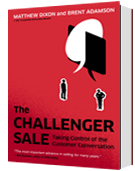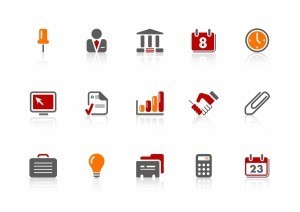Brent Adamson's Blog, page 31
February 20, 2012
Marketing Automation: What It Means for Sales
 You may have heard the increasing buzz from your marketing department about "IMA", or "inbound marketing automation." But what exactly does it mean? And why all the hype?
You may have heard the increasing buzz from your marketing department about "IMA", or "inbound marketing automation." But what exactly does it mean? And why all the hype?
To give you some context, inbound marketing is about optimizing the availability of your content. Marketing automation refers to the use of technology to automate marketing tasks, such as lead tracking or scoring, and to distribute content to prospects based on their actions. For instance, if a prospect registers on your site and downloads a specific white paper, your marketing team can send related communications the prospect may also be interested in.
Together, you get inbound marketing automation (IMA).
So what are the implications of IMA for you and your sales force?
The goal of IMA is to enable marketing to help provide sales more qualified leads. Marketers can use it to track a customer's activity, and send more tailored communications based on materials prospects download or access from your site or emails over time. When the potential customer's actions indicate they have formulated a need and are ready to talk to a rep, marketing can alert sales to reach out to the prospect.
While inbound marketing automation seems like a potentially useful tool to help sellers in opportunity identification, there are a few important things to keep in mind:
The value IMA creates depends on your working relationship with marketing. If you rarely collaborate with your current marketing team, IMA may lead to more stress and anxiety than qualified prospects. If you decide that IMA is right for your sales organization, first reevaluate your working relationship with Marketing. After all, you will both have to agree on the criteria that constitute a qualified lead and the lead scoring system. ( SEC Members , to assess your current relationship with Marketing, use our Commercial Integration Diagnostic).
Inbound marketing automation largely operates in the world of established demand. IMA is about getting the customer to come to you when they have identified a need (or at least know they have one), and are ready to buy. Thus, the buying process is more than likely still going to happen on your prospect's terms. IMA will help you get in before our infamous 57% arrow, but how much earlier may vary.
Automated content marketing is not a substitute for sharing of insights. Sure, you can forward white papers to potential leads, but there is a difference between delivering ideas via online articles and having a face-to-face dialogue where you share new insights, industry trends and personalized stories with a prospect.
So the bottom line is that yes, IMA could enable Marketing to better support your sales reps by identifying more quality leads in the realm of established demand (See last year's research on established vs. emerging demand opportunities). However, it's still up to sales people to analyze and prioritize prospect quality, especially in the ambiguous emerging demand space.
SEC Members, to learn more about pursuing opportunities in the emerging demand space, see the latest updates on our 2012 research which explores the pre-sale activities vital to creating demand.
What are your thoughts on marketing automation? Have you invested in this at your sales organization?
February 15, 2012
4 Ways to Tackle Change Management

In a world where uncertainty and complexity is a constant reality, managing transformative change has become a new normal for a growing number of sales organizations. To make matters worse, companies aren't experiencing just one change at a time – a survey from the Communications Executive Council tells us that companies have gone through an average of 3.5 substantial changes over the past 2 years. And that's a lot, considering it takes employees an average of 24 months to recover from a single corporate change.
Whether it's restructuring, senior leadership transitions or integrating a new sales force, employees are faced with changes that cause them to be constantly stressed out. Yet another data point to make you cringe: this change-fatigue-driven stress creates a 9-10% drag in employee performance.
And as we continue to consider our sales organizations' ability to stay ahead of a complicated selling environment regardless of internal turmoil, this performance gap is a huge red flag when it comes to future growth.
But if your sales organization is about to stomach another transformative change, the outlook does not have to be so dismal. To get ahead of this downward spiral, we've seen progressive companies find successes in enabling the employee to be the "locus of control".
Put another way, both known and unknown changes can cause less of a blow when we use tactical strategies to put our front-line staff in the driver's seat.
While there's no way around an ever-evolving sales organization, using an innovative approach to leadership can empower reps to collaborate with peers and act smarter and stronger when taking on a major corporate change.
Though it may seem vague or difficult to make reps the "Mobilizers" of internal change, enabling them to lean in to help drive the change isn't an impossible dream.
If we think of transformative change as something more concrete – like rolling out a new CRM or building excitement for an upcoming training initiative – we can build our reps' ability to adapt in the face of change using these four strategies:
1) Make Change an Emotional Journey: Because change adoption accelerates through various phases of commitment, use a Commercial Teaching Choreography to help your sales force shift from awareness of change to internalizing the change as an agile employee. The emotional journey encourages a high degree of self-discovery, which increases reps' understanding and appreciation of the transformative change. Learn how ADP used a teaching choreography to appeal to emotional highs and lows before offering a new way forward.
2) Generate Demand to Build Momentum: Building bottom-up, viral "buzz" enables reps to generate organic acceptance for the change instead of mere leadership-driven compliance. ADP sparks initial curiosity for new changes and uses socially connected reps to continue building interest to boost the internalization of change. Here, ADP knocks down barriers to communication by opening doors to sharing new ways of thinking and working.
3) Use Peers to Enable Self-Discovery: While managers are necessary change agents when it comes to communicating the strategic goals of a given change, a manager-led approach is insufficient in driving rep support for change. See how Saudi Aramco uses peer speakers (p. 21) to publicly share their personal connection to corporate challenges and provide tangible examples for other employees to re-create.
4) Highlight Success Stories of Early Adopters: W.W. Grainger found that reps will naturally cluster into one of the following time-based segments when deciding whether to embrace change: Early adopters, Majority, Laggards and Naysayers. By gradually increasing the closeness of change-adoption through peer success, the Majority and Laggards will see their neighbors embrace change and realize immediate applicability for behavioral change.
What other strategies have been successful for you in managing transformative change? Feel free to add your perspective in the comments section below.
SEC Members, check out the replay from our webinar last week on Building a Change-Ready Sales Organization to learn more about how we can use different tactics to build an environment that encourages action from the bottom up to ease the disruption caused by change.
February 14, 2012
Turn Your Reps into Commercial Coaches
 The next time you head out to sell a solution to a customer, think about it from this perspective – this may be the first time your customer is ever purchasing this solution. So why do we frequently let the customer tell us how the sale should proceed? And even if they have purchased this solution before, it's likely been years… and many of the players and much of the internal politics are now different. Do they know the best path forward?
The next time you head out to sell a solution to a customer, think about it from this perspective – this may be the first time your customer is ever purchasing this solution. So why do we frequently let the customer tell us how the sale should proceed? And even if they have purchased this solution before, it's likely been years… and many of the players and much of the internal politics are now different. Do they know the best path forward?
Now think about it from this perspective – as sales professionals, it's our JOB to sell these solutions, day in and day out, to a wide range of customers, each with a very different set of circumstances. There isn't much we haven't seen go right and go wrong.
All of those lessons learned are incredibly valuable, and can be used to coach the customer on how the sale should proceed. Help them avoid mistakes, prepare for obstacles or objections, and make their purchase experience smooth and easy. We call this Commercial Coaching.
We first uncovered that the best reps out there are coaching their customers through the sale in our latest work on the New High Performer Playbook. Star reps are not out there indiscriminately talking to anyone, they're very purposefully seeking out Mobilizers to help them build the case for change and build consensus. But once stars find a Mobilizer, they don't just hand over the reins and walk away – they very actively coach the Mobilizer through the consensus building process.
If you haven't seen the Mobilizer and Commercial Coaching work yet, you'll want to start there. But if you are ready to start building your own versions of the tools, then this blog post is for you.
These are some lessons we've learned from members across the last several months as they've taken these ideas and tools and adapted them to their world.
Lesson 1: Half the battle is building a Commercial Coaching mindset.
You have to sell reps on the need to be commercial coaches, and don't overlook how much of a change this is for most reps. Show them why the mentality that "the customer knows best" is a dangerous mentality. Unfortunately, that mentality incorrectly assumes the customer knows who all the key players are in their business relative to this solution, why they might object to the solution, how to overcome those obstacles and gain consensus, and how to do all of that with some political savvy. Teach reps that it's ok to be a little more prescriptive. We're not asking you to outright tell the customer what to do (that WOULD be bad), but to make suggestions and collaborate with the customer to come up with next steps.
Lesson 2: Build collaborative tools to help reps have constructive conversations with customers.
The hardest part about having a conversation you're not comfortable having often times is just how to bring it up. The first half of that battle is asking leading questions. The Commercial Coaching Toolkit lists out self-discovery and collaborative questions to prompt your Mobilizer for a response. But if that's not enough, offload that burden a bit by building tools that reps can use at different stages in the customer's buying process.
One of our favorites comes from Business Objects, and it's called the "Sequence of Events." Sit down WITH your Mobilizer, and together map out all the potential next steps. Or better yet, have a pre-populated one (with common pitfalls already embedded) and let the Mobilizer customize it.
That way, when the Mobilizer asks "why would that step be in there?" the rep can respond by teaching the Mobilizer the danger of not including that step and coaching them through how to avoid it.
ADP builds on that concept by building tools to coach customers at every step in their buying process – starting from the initial sales call with one Mobilizer all the way through organizational consensus and implementation of a solution.
Lesson #3: Celebrate your failures.
The best way to build a tool like the Sequence of Events is to ask your reps about the worst deal that ever fell apart or got derailed. Those are all stories to build into pitfalls and embed into your Commercial Coaching Roadmap.
To illustrate this, I'll share the story we like to tell of an enterprise software company who, after a few months of pursing a deal, got the go-ahead from the Customer's CEO…but then found out a week later that not even the CEO had the authority to make purchases like this. Purchases of this size had to go to the board of directors for approval. Now, the good news is that story had a happy ending because they won the deal. But they had to wait TWO AND A HALF MONTHS for the board to reconvene. That's a great potential next step to go into your sequence of events – consult the board!
If you can find potential obstacles from past deals, you can better anticipate ways to coach your customer through the difficult world of consensus building.
SEC Members, visit our new Commercial Coaching topic center for more resources and tools, or check out our webinar replay on the topic.
February 13, 2012
Putting the Swagger Back in Sales
 Matt Dixon and Brent Adamson, authors of The Challenger Sale, were recently featured in Sales & Marketing Management, where they explained the logic behind the controversial notion that complex B2B sales is more about confidence and less about relationships.
Matt Dixon and Brent Adamson, authors of The Challenger Sale, were recently featured in Sales & Marketing Management, where they explained the logic behind the controversial notion that complex B2B sales is more about confidence and less about relationships.
Here are excerpts from the Q&A:
SMM: There has been a lot of debate online about the theories you propose in your new book. Before we get to those, however, why did the world need another sales book?
BRENT ADAMSON: When we set out on this project, we never had any intention to write a book. At the Corporate Executive Board, we spend all of our time researching the world of sales as deeply as we can to understand what great looks like. The thing that sets this apart from a lot of sales books that are out there is that everything in it is data driven. It is driven off a huge amount of quantitative research that you rarely see in the sales industry and particularly in the sales book industry. Most of the books out there, when you read the author bios, tell you that it's "based on my 30 years of experience of carrying a bag and running big sales accounts and bagging the elephant or winning the whale," or whatever it is they do. I mean no disrespect, but that's just not how we think about sales. We study sales very meticulously from a quantitative and qualitative perspective to understand what great looks like.
When we landed on this Challenger work, we talked to heads of sales at our member organizations. The thing that struck us as so different about this work is that it really was changing – radically in some cases – the way people thought about how they were currently operating. When you look at this data and all that it implies, it takes so much conventional wisdom and stands it on its head and tells us that much of what we've been doing is, in fact, incorrect. It was the right story for the right time.
MATTHEW DIXON: The view that sales excellence is something derived by simply making individual sellers better at what they do has been one propagated since the 1970s with very little variation on the theme. The real breakthrough that we think we bring to the table with The Challenger Sale is that on the surface it's certainly a story about sales professionals themselves and about the skills required in today's sales environment, but it's as much a story about the organization.
Our view is that companies now need to not just develop individual skills, but bring new organizational capabilities to bear to change the nature of the sales conversation. The short answer to this is for years and years, while we were focusing on making salespeople better, customers went away and became much more sophisticated in how they buy. We never really caught up to that, so what we see now is individual salespeople doing battle in the market against sophisticated customer organizations. Our view is you need capable sellers, yes, but you need sophisticated supplier organizations to level the playing field against a sophisticated customer organization.
So much of what we talk about in the book is about how you identify your unique benefits and how do you surface teachable insights that you can then equip your salespeople to deliver to customers. Those things have to be done by the company. They're not just something that individual sales reps can come up with on their own.
SMM: You interviewed more than 6,000 sales reps across nearly 100 companies in multiple business-to-business industries for this data. What were you going after?
ADAMSON: As a membership research organization, we take our marching orders from our members – the heads of sales at big B2B companies. The problem that they were all wrestling with in the late months of 2008 was "How do I save my job? Our people are missing quota left and right!" And yet, within every sales organization that was hemorrhaging with quotas being missed all over there were still a handful of salespeople in every one of our member companies that were not just hitting goals, but in many cases exceeding goals. The question as to what these people were doing became incredibly pressing for them at that moment in time. They were looking to figure out what those folks were doing differently and could they bottle it and export it to everyone else.
Originally, when we hypothesized what the answer would be, we suspected we'd get maybe a couple of skills that would emerge as really important right now. But when we ran the analysis, something fascinating happened. We found that the behavioral skills and the attitudes clustered together and moved together in five specific groups, which became easily identifiable by the profile names we use: Relationship Builders, Hard Workers, Lone Wolves, Reactive Problem Solvers and Challengers. They became proxies for actual salespeople and how they engage the customer. It was not what we were expecting to find, but oftentimes that's where we find our best work comes from.
SMM: You state that Challengers use their deep understanding of their customers' businesses to push their thinking and take control of the sales conversation. Your research indicates that they dominate the world of complex B2B sales. Why and how?
ADAMSON: Most sales reps, when they show up in front of a customer, rely pretty heavily on their product, their brand, or the service with which they deliver that product to differentiate themselves from competitors in the eyes of that customer. When you think about it, how could you not go in with a certain amount of swagger when you've got one of the world's great brands behind you?
What we found when we spoke with customers is they just don't see it that way. Customers don't see significant differences in one supplier versus another in terms of their brand, their product or their service. Yeah, they likely differentiate the top three from everybody else. But what customers told us is they just don't see as large of a difference between one company and another in terms of product, brand or service.
It becomes a difficult proposition for a sale rep to differentiate themselves in the eyes of the customer based on those attributes. What we did hear again and again is where they do see the difference is in the actual interaction itself – the actual sales experience. They say, "You've got a great brand, they've got a great brand. But I'll tell you that you just wasted my time and this other guy provided amazing insight that's hugely valuable." That's what gives you a leg up today in this world – not so much the products and services you sell, but the quality of the insight that you deliver as part of the sale itself. That's the current biggest incremental opportunity for differentiation for virtually every company and every sales rep out there.
SMM: Your message is for reps to know more about their customers' business than they do so they can carry that swagger and come in with new ideas. Is that realistic?
DIXON: We have animated debates with people all of the time about the need to ask questions. That goes to the root of what you're asking. The conventional wisdom is that I as a salesperson cannot be so presumptuous as to show up in a customer's office and teach him or deliver insight. I first have to understand his business, his problems and his pain points, and the way I do that is by asking questions.
There have been millions and millions of dollars – I'd go to billions, but I'm not sure if that's actually true – spent across industries to get salespeople to ask better questions. It's very clear in the data that we collected that that sort of sales approach delivers no value to the customer. This is a very surprising thing for salespeople to hear. When we talk to customers, what they tell us is, "Don't show up and ask me what keeps me awake at night. Show up in my office and tell me what should be keeping me awake at night. You should know. You work with people like me all of the time, whether it's exact companies in this same industry or you talk to people who have the same kind of responsibilities that I have across industries. I don't know what I don't know. Come to my office and make me smarter about those things I am unaware about."
In other words, show up with insights from your many, many other conversations and bring those to bear. It's something that salespeople are very hesitant to do, often in the desire to show empathy.
SMM: You've gotten pushback on the whole concept. Many salespeople have bristled at your suggestion that Relationship Builders, as you define them in your book, will have their lunch handed to them by Challengers. What's your response?
DIXON: We hear heads of sales say they don't like the term "Challenger" because it may send the wrong message of being pushy and aggressive with your customer. We understand. But when you explain that the profile is not about being aggressive, but rather about having confidence in your knowledge of the customer's business and your ability to deliver value, that's very different from being pushy and being a jerk. The danger you run in changing the name is you never create a dissonance between the old way of doing things and the new way of doing things. One of the great things about the Challenger term is you can say it to just about any sales leader and they almost instantly get what you're talking about. You've given language to something they've kind of known in their guts to be true but never had a word for.
ADAMSON: We've gotten pushback from day one, and for good reasons – it's counterintuitive. We mostly hear two things: "We can't do this" and "Customers don't want it." Where we land on the "we can't do this" is the story is just as much about organizational capability as it is individual skill. It's hard to overemphasize that point. The idea that you can bring in a sales training organization and train up your sales reps to be Challengers and call it a day is missing the broader point of what this body of work is really telling us, which is that it's a story of commercial transformation, whether it's sales, product development or marketing. It is transforming every aspect of anyone who is involved in creating the experience that you use to face off with customers because it means you have to answer: What are the unique benefits that we bring to market that can set us apart? What are the ways in which customers don't understand their business that leads them to undervalue those capabilities? How do we build a story around those insights that leads to those unique insights? And how do we put those into collateral and send it out with the sales force?
SMM: Is your message to sales managers that they need to turn their reps into Challengers no matter what?
DIXON: The reality is that we've seen it proven over and over that most salespeople can actually be equipped through the right training, coaching and tools to at least play the role of the Challenger in front of the customer even if that's not their natural predisposition. Because salespeople have a baseline across all of these attributes, it's really a question of just teaching them how to flex some of these other muscles that maybe have been discouraged internally. The reason people get to the Challenger ideal is one more of will, not skill. They reject the new model because they "didn't sign up to be that kind of salesperson."
ADAMSON: This story isn't really about these profiles at all. It's about the behaviors that drive success. No matter what profile you're put in or that you self-diagnose yourself to be in, at the end of the day, it's about modifying your behavior – putting new tools in your toolbox, if you will – to allow you to behave in a way that is more consistent with the behaviors that our data shows are more likely to drive success.
SEC Members, to learn more about implementing the Challenger approach in your organization, visit our new Challenger Selling Topic Center or review more Challenger FAQs.
February 8, 2012
5 Tips For Establishing a Sales Certification Process
 Here's a pair of surprising statistics: 60% of our members tell us that they would love to establish a formal skills certification process for their teams, but guess how many have actually done it?
Here's a pair of surprising statistics: 60% of our members tell us that they would love to establish a formal skills certification process for their teams, but guess how many have actually done it?
Only about one in every four (see page 43).
So the big question on our mind is – what seems to be the hold-up?
Establishing a certification process for Sales is not easy, particularly for front-line salespeople. In fact, many of the most robust certification programs we've seen from companies like HP, British Airways, and Kohler are not geared toward sellers at all! The focus instead is placed on the certification of line management, a critical challenge in its own right, but one that does not address what to do with all the sales people being cycled through our training and onboarding curriculums.
Fortunately, there are some early lessons from the few but brave member companies we have seen embarking into the world of sales rep certifications. We've summarized the top five here:
Lesson #1: Certify based on Long-Term Results rather than Short Term Activities. We've seen Electrolux follow this one to the tee, and the impact has been impressive. By avoiding certifying reps based on the completion of three week training curriculum alone, and instead looking for ongoing demonstration of competency over the course of a full year, Electrolux has seen that when they finally do certify someone, they turn out to be a demonstrably stronger seller. On average, certified account managers are delivering nearly 6% greater net sales growth per year than their uncertified peers.
Lesson #2: Embed the Certification Process in Salespeople's Day-to-Day Roles. Instead of certifying based on performance in the classroom or completion of a test, Electrolux bases certification purely on field application of learned skills, tools, and internal support resources. Sellers must demonstrate proficiency with real customers over time, shifting the focus from certifying acquisition of knowledge alone to certifying the acquisition and application of skills.
Lesson 3: Award Certifications Based on Customer Outcomes rather than Seller Actions. Instead of measuring their salespeople, Kennametal requires sellers to document the cost savings achieved by their customers before they are nominated for certification. What do reps gain in return? Certified reps receive a 5-10% bonus to reward the additional value they've proven they can create for customers.
Lesson #4: Make Certification Exclusive. The lesson here again comes from Kennametal, where certified sales reps get a unique icon stamped on their business cards to signal their "certified" status. The impact? A sizeable proportion of the sales force has begun voluntarily opting into the certification program in hopes of achieving "status" themselves.
Lesson #5: Use Managers as Stage Gates. When it comes to certifications, nothing is a bigger waste of time than putting reps through the formal sign-off process only to have them fail. To limit this inefficiency , Gen-I Australasia established a manager nomination process whereby salespeople must prove that they've mastered required competencies before they can apply for certification and be exited from an rolling Sales Academy curriculum. The result is an 89% graduation rate – not because the test is easy, but because candidates rarely enter unprepared.
What other lessons have you learned in implementing sales certification program? Please feel free to share in the comment section below.
SEC Members, for more on sales skill development and certification, visit our topic center on Sales Training.
February 7, 2012
4 More Trends in Sales Org Structures
A few months back, I posted some early findings from our 
benchmarking research on sales organizational structures. Since then, we have gone on to profile the sales structures of 30 member companies.
Here's a quick round up of some of the additional sales org structure trends we're observing:
Trend #1: Flatter Sales Organizational Structures:
Partly a result of the economic downturn, sales organizations have significantly cut down their organizational hierarchy and are looking to maintain their lean structure as the new normal. The emphasis is on increasing front line accountability and driving efficient decision making, while at the same time, providing senior leaders with visibility into field operations.
Trend #2: Increased Sales and Marketing Collaboration:
Despite growing recognition of the need for greater Sales and Marketing collaboration, most companies continue to operate the two functions as distinct silos, with Sales operating locally while Marketing residing in the regional/global headquarters. A clear trend for sales organizations is to actively remove organizational structure impediments between sales and marketing staff to allow interaction and alignment of activities toward a common goal. Best practices include establishing formal cross-functional communication channels, aligning incentives and performance metrics, and creating a common vocabulary for sales and marketing activities.
Trend #3: Moderating Manager Span of Control:
Sales managers, with a mandate for growth, are being asked to do more with less. This has resulted in managers not only taking on more reps, but also often spending a disproportionate amount of time on direct selling activities. That said, we are seeing this trend slowly reverse with companies gradually reducing the burden off managers by reevaluating their overall span of control and reorienting manager time to strategic planning and coaching activities.
Trend #4: Dedicated Hunter and Farmer Reps:
Under pressure to bring in new business and grow existing business, many sales organizations attempt to create hybrid reps that are equally skilled at both hunting and farming. However, training reps or tweaking rep compensation plans to drive hunter and farmer behaviors often fails as reps are predominately oriented to only one of these profiles. A clear trend is emerging to accommodate distinct hunter and farmer roles. This allows sales organizations to tap into both hunters' new business skills, and farmers' account management skills.
Do you also see these trends play out in your organization? Any others you'd add to this list?
SEC Members, visit our new key findings page, Benchmark Your Sales Organizational Structure, to review the complete list of org trends, and benchmark your structure against 30+ profiled companies.
February 6, 2012
The Future of Video Calling for Sales and Customer Service
(This is a guest post by Matt Lind of the Customer Contact Council, our sister program for heads of customer service and contact centers.)
 If you own a smartphone, tablet, or laptop computer (okay, that should cover just about everybody), then you're likely familiar with the slick video-recording capabilities that now come standard on these gadgets. And if you're like me, you've been wowed at the ability of face-to-face video conferencing to bridge physical limitations, seemingly bringing people much closer together, even if only in a 'virtual' sense.
If you own a smartphone, tablet, or laptop computer (okay, that should cover just about everybody), then you're likely familiar with the slick video-recording capabilities that now come standard on these gadgets. And if you're like me, you've been wowed at the ability of face-to-face video conferencing to bridge physical limitations, seemingly bringing people much closer together, even if only in a 'virtual' sense.
With technology enabling the world to better capture, store, and share video content, we've certainly seen a rise in the number of organizations wondering how they can use video to serve their customers.
Indeed, the recent and rapid rise of services like Apple's FaceTime, Google Hangouts, and Skype naturally leads us to think about the potential for sales and service organizations to leverage this technology, and while it's certainly too early to say for sure, here's my take on the future of video calling for sales and service:
Employee-to-Employee
Companies looking to at least experiment with the benefits (and limitations) of video calling are likely to first pilot the technology internally, using their employees to prove (or disprove) the value in using video calling with customers.
(SEC Members, learn more about running effective pilots for new tools and technologies.)
This pilot phase needn't be restricted to just the call center, though; in fact, the biggest benefits may be found in enabling better communication and collaboration between the field and other areas of the organization. For example, we've heard from a few financial services organizations considering video capabilities between branch employees and call center staff. In addition, video conferencing often comes up in the context of coaching and engaging with remote reps.
Employee-to-Customer
In my mind, face-to-face video calling between organizations and their customers isn't likely to become 'the next big thing' in the immediate future, but that future is certainly up for debate. With video increasingly becoming a part of people's social lives, it stands to reason that customers may become more comfortable with the idea of video conferencing as a convenient sales or service option. We needn't look further than social media as an example of a recent cultural change that's had a big impact on the sales, marketing, and customer service world; maybe video is poised to be the next example of just such a change?
The extent to which organizations are rolling out iPads® and tablets to the sales force (75% are already using the technology or plan to use it within the next 12 months) perhaps suggests this may very well be the case.
On the other hand, for most customer issues, video calling just doesn't seem to offer much added benefit to the customer that couldn't be achieved via today's phone or web chat interactions. But for certain issues there may just be value in having a helpful rep to talk you—and show you—through the mechanics of the solution to your problem.
I can think of at least several times when I've called a repairman for something that turned out to be a simple fix—something I could have repaired myself by watching someone who knew what they were doing. Maybe this is taking the idea of customer "self-service" a bit too far, but there's no denying the potential of video to be valuable for certain customer issues.
What's your experience with video applications—either internally or in customer-facing scenarios? What do you think about the future of video in the sales and service organization?
January 31, 2012
The Top 11 iPad Apps for Sales
 As iPads® and tablets become more prevalent in the sales world, there is a lot of buzz around the many ways in which they could be useful. With more and more sales organizations adopting these technology, one thing is clear – the potential impact these devices can have on a sales rep is immense.
As iPads® and tablets become more prevalent in the sales world, there is a lot of buzz around the many ways in which they could be useful. With more and more sales organizations adopting these technology, one thing is clear – the potential impact these devices can have on a sales rep is immense.
Whether as a state of the art presentation platform, or a tool for accessing the latest sales collateral in the field, iPads and tablets allow for easy access to information as well as increased efficiency.
Given the volume of app options though, it is important to find out which of the thousands are actually worth downloading. Whether it's cutting long lines at the airport, or pulling together a presentation on the fly, there are a number of great apps that every sales rep should know about.
The most popular apps for sales fall into four broad categories:
Travel and expense
Document editing and viewing
Sales Enablement
Presentation and meeting support
Our members recently shared their opinions on the top apps in each category, and we've compiled a list of their top recommendations.
One popular recommendation is the Concur app. This app simplifies travel and expedites expense reporting, offering many features that save time while on the road. It allows users to take pictures of receipts using an iPhone/iPad camera and automatically upload the image to their account. You can also check on travel arrangements and book hotels from a tablet device.
Another member favorite is the Urbanspoon app. Urbanspoon uses your current locations to determine nearby restaurants. Search results can be categorized by distance – or for the more adventurous, the "shake" feature allows for a random selection.
Other popular apps for sales include the Keynote app, which allows you to build a presentation on the go, or the Salesforce app which allows you to quickly access your CRM data and easily edit client information.
But these are only a few of sales organizations' favorites…
SEC Members, check out the entire list of top iPad app recommendations.
Do you have any favorite apps? Feel free to comment and help add to our list!
How to Give 2 Hours a Month Back to Reps
 "I don't have time for another one of these! I've got to be in-front of my customer!"
"I don't have time for another one of these! I've got to be in-front of my customer!"
Have you heard that from your sales force lately? Maybe someone's even said it today. The "these" referenced above are the multiple internal tugs at a sales force's time…things such as meetings, surveys, reviews and trainings that internal partners hold.
Why are these things so problematic? Because time spent fulfilling internal company requests is time NOT spent selling.
So how do you ensure that the sales force has time to achieve its primary objective of selling while still meeting the demand of valuable internal requests?
We profiled an organization that tackled this challenge head on…Schneider Electric (one of the world's largest manufacturers of equipment for electrical distribution and industrial control and automation) came up with a pretty straight-forward solution: they put a communications screening process in place.
Schneider no longer lets requesters go directly to sales reps or managers with their asks, but rather, the Schneider calendar team screens the requests to 1) identify the value of it and 2) manage the time investment for it.
The Schneider screening process requires internal functions to provide a business case to the sales calendar team, deferring communication submissions that don't have tangible business value. On the back end, the sales calendar team actively enforces the time caps on the approved requests and manages any overages month to month.
Not only can this help identify the most valuable activities for sales reps to attend or take part in, but it also takes the screening task off of managers' plates, removing at least one "resource allocation" activity from them. (In fact, our recent manager research found that these "resource allocation" activities are not the greatest levers in driving manager effectiveness, but that selling, coaching, and sales innovation are greater drivers of manager success.)
So, what results did Schneider Electric see with this communications screening process?
A decrease in overall volume of requests
2 hours per month "returned" to reps
An increase in customer-facing time by 11%
SEC Members, learn more about how Schneider Electric created and implemented this communications screening process. You can also listen to our webinar replay featuring this best practice.
In the future, rather than hearing "I don't have time for another one of these", maybe you'll be hearing "I used one of those valuable activities to close another deal in the pipeline."
January 30, 2012
The Top 10 Super Bowl Ads of All Time
It's that time again! In honor of the big game this weekend, we're reposting our top 10 Super Bowl ads of all time. Enjoy!
The Super Bowl is back—meaning it's time to stock up on Buffalo Chicken dip, kick back in front of the TV and watch some of the best commercials you'll see all year. Or, catch some football. Whether you're a sports fanatic or not, the creative ads airing between tackles are always highly anticipated. As well they should be—advertisers shell out close to $3million for a 30-second spot.
While some ads miss the mark, many make such an impact that we still talk about them years later. We've compiled a list of our top Super Bowl ads ever for your very own trip down memory lane:
Apple — 1984
There's been a lot of hype lately about the launch of newer Apple products such as iPhones and iPads—but the original Macintosh, too, had its own unveiling. The "1984" commercial gives a nod to Orwell's novel of the same name, and indicates that the Macintosh will save society from Big Brother's conformity. The ad is visually unique, striking, and has been named to the No. 1 spot on Best-of lists by TV Guide and Advertising Age.
Budweiser — Respect
After 9/11, Budweiser ran this commercial in the 2002 Super Bowl—and it was the only time the ad has ever aired. It's a stark contrast to the beer company's often funny ads, but this is why the commercial is especially memorable. Budweiser didn't use this spot to sell their product. Instead, they used it to acknowledge the tragic event and pay their respects, as their famous Clydesdales lowered their heads and dropped to one knee before the New York City skyline.
Coca-Cola — Mean Joe Greene
Sorry, Packers fans, but your opponents were a part of one of the most well-liked Super Bowl spots. In this ad, "Mean Joe" Greene limps off the field in a surly state, not to be bothered by anyone, especially not a little boy. But after drinking the offered bottle of Coke, Mean Joe tosses the kid his jersey and breaks into a huge smile—because as the commercial wants us to think, Coca-Cola can make anyone, even Mean Joe, happy.
Budweiser — Frogs
This is the first commercial I remember from watching Super Bowl. You know why? Because for months afterward, I still quoted "Bud. Weiiiis. Er." any chance I got (along with every other corny person who thought it was funny to do so). The point is that this campaign stuck. It was catchy. And with a few frogs croaking in a swamp, Budweiser embedded their product into our minds—and appealed to consumers across generations.
Snickers — Game
Have you ever turned into a crabby version of yourself when you're hungry? Snickers makes a play on this idea in their ad campaign that shows Betty White getting sacked on the football field. After eating a Snickers bar, the guy morphs back into his normal state. It's impossible not to laugh (who doesn't love Betty White?)—and, in this case, humor works, because USA Today's Ad Meter showed the football sketch to be ranked No. 1 by consumers the day after the Super Bowl.
Google — Parisian Love
From looking for study abroad programs in Paris, to learning how to impress a French girl, to finding the location of churches for a wedding—Google's ad tells us one life story, all through what's typed in the company's search bar. Google's commercial doesn't outright sell their product. It showcases how one of the company's tools can be used to solve any major life questions imaginable.
Reebok — Terry Tate: Office Linebacker
Are you breaking office rules? Watch out, because you might get tackled by fictional linebacker Terry Tate. Reebok's short series of commercials is one of the funniest and successful ad campaigns to have aired during the Super Bowl. Even though the commercials ran only once on television, just one month after the Super Bowl more than 7 million consumers had gone to the Reebok site to download the Web films. These ads are hilarious because, well, who hasn't dealt with an irritating coworker before?
McDonalds — The Showdown
In one of the most epic games of H-O-R-S-E documented, nemeses Larry Bird and Michael Jordan duke it out—for a Big Mac. They start off with simple shots and the commercial ends with the players discussing their next ridiculous move of bouncing basketballs off billboards, over expressways and off of rooftops. The ad appeals to sports fans and fast-food junkies alike. But, it's also impossible to not get a laugh out of Michael Jordan's MCHammer-esque get-up.
Xerox — Monks
Think about how many copies of office documents you make on a weekly basis. Now, imagine how much time it'd take to write out each of those by hand. In this ad, Brother Dominic is instructed to produce 500 copies of an old manuscript. Instead of panicking, he goes through a hidden passage that brings him to a modern-day office where a Xerox machine can make the copies for him, at the rate of two pages for second. The head monk describes the quick job as "a miracle." Aired back in 1977, the "Monks" commercial led the way for the humorous, tongue-in-cheek commercials of today. And, when a company name becomes a verb for the product it sells, they must be doing something right.
Pepsi — Apartment 10G
Some guys will do anything for a pretty girl—in Michael J. Fox's case, that means climbing out the window, running down streets through the rain—all to get a Diet Pepsi for his new neighbor. Not to mention that the commercial is set to great 80s music. The commercial as a whole makes an appeal to a younger audience, and advertises Diet Pepsi as "The choice of the new generation."
Brent Adamson's Blog
- Brent Adamson's profile
- 9 followers




